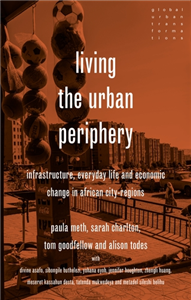Living the urban periphery
Infrastructure, everyday life and economic change in African city-regions
by Paula Meth, Sarah Charlton, Tom Goodfellow, Alison Todes
Description
More Information
Rights Information
Albania, Algeria, Angola, Argentina, Armenia, Australia, Austria, Bahrain, Belgium, Belize, Benin, Bolivia, Bosnia and Herzegovina, Botswana, Brazil, Bulgaria, Burkina Faso, Burundi, Cameroon, Canada, Cape Verde, Central African Republic, Chad, Chile, China, Colombia, Comoros, Congo [DRC], Congo, Republic of the, Costa Rica, Ivory Coast, Croatia, Czech Republic, Denmark, Djibouti, Ecuador, Egypt, El Salvador, Equatorial Guinea, Eritrea, Estonia, Ethiopia, Faroe Islands, Finland, France, French Guiana, Gabon, Gambia, Georgia, Germany, Ghana, Greece, Guatemala, Guinea, Guinea-Bissau, Guyana, Honduras, Hongkong, Hungary, Iceland, India, Indonesia, Iran, Iraq, Ireland, Israel, Italy, Japan, Jordan, Kazakhstan, Kenya, Kuwait, Latvia, Lebanon, Lesotho, Liberia, Libya, Lithuania, Luxembourg, Macau, China, Macedonia [FYROM], Madagascar, Malawi, Malaysia, Mali, Malta, Mauritania, Mauritius, Mayotte, Mexico, Mongolia, Montenegro, Morocco, Mozambique, Namibia, Netherlands, New Zealand, Nicaragua, Niger, Nigeria, Norway, Oman, Pakistan, Panama, Paraguay, Peru, Philippines, Poland, Portugal, Puerto Rico, Qatar, Reunion, Romania, Russia, Rwanda, Saint Helena, Sao Tome and Principe, Saudi Arabia, Senegal, Serbia, Seychelles, Sierra Leone, Singapore, Slovakia, Slovenia, Somalia, South Africa, South Korea, Spain, Sri Lanka, Sudan, Suriname, Swaziland, Sweden, Switzerland, Syria, Taiwan, Tanzania, Thailand, Timor-Leste, Togo, Tokelau, Tunisia, Turkey, Uganda, Ukraine, United Arab Emirates, United Kingdom, United States, Uruguay, Venezuela, Vietnam, Western Sahara, Yemen, Zambia, Zimbabwe, South Sudan, Cyprus, Palestine, Bangladesh, Cambodia, Liechtenstein, Azerbaijan, Jamaica, Kyrgyzstan, Dominican Republic, Myanmar, Monaco
Endorsements
The edges of cities are increasingly understood as places of dynamism and change, but there is little research on African urban peripheries and the nature of building, growth, investment and decline that is shaping them. This multi-authored monograph examines African urban peripheries through a dual focus on the logics driving the transformation of these spaces, and the experience of living through these changes. As well as exploring the generic dynamics of peripheral change across the continent, it provides rich qualitative insights into the specificity and distinctiveness of a range of peripheral locations. Using substantial comparative empirical data from city-regions in Ethiopia, South Africa and Ghana, in conversation with research in other African contexts, it provides a cogent analysis of spatial transformations and everyday life on the African city periphery. It argues that urban peripheries are formed through five distinct but interconnected logics that capture the complexities of periphery formation and changes therein. However, it illustrates that to fully understand the nature of change in urban peripheries we need to situate these logics in relation to the varied lived experiences of people living there. Developed within a framework of comparative urbanism, the book considers multiple issues, including economic and infrastructural transitions, political practices, social outcomes and differences, and spatial and material changes. In order to bring the realities of 'living the periphery' to life, the book foregrounds the voices of residents throughout, supported by visual images.
Reviews
The edges of cities are increasingly understood as places of dynamism and change, but there is little research on African urban peripheries and the nature of building, growth, investment and decline that is shaping them. This multi-authored monograph examines African urban peripheries through a dual focus on the logics driving the transformation of these spaces, and the experience of living through these changes. As well as exploring the generic dynamics of peripheral change across the continent, it provides rich qualitative insights into the specificity and distinctiveness of a range of peripheral locations. Using substantial comparative empirical data from city-regions in Ethiopia, South Africa and Ghana, in conversation with research in other African contexts, it provides a cogent analysis of spatial transformations and everyday life on the African city periphery. It argues that urban peripheries are formed through five distinct but interconnected logics that capture the complexities of periphery formation and changes therein. However, it illustrates that to fully understand the nature of change in urban peripheries we need to situate these logics in relation to the varied lived experiences of people living there. Developed within a framework of comparative urbanism, the book considers multiple issues, including economic and infrastructural transitions, political practices, social outcomes and differences, and spatial and material changes. In order to bring the realities of 'living the periphery' to life, the book foregrounds the voices of residents throughout, supported by visual images.
Author Biography
Paula Meth is Reader in the Department of Urban Studies and Planning at the University of Sheffield, and Visiting Associate Professor in the School of Architecture and Planning at the University of the Witwatersrand. Sarah Charlton is Associate Professor in the School of Architecture and Planning at the University of Witwatersrand. Tom Goodfellow is Professor of Urban Studies & International Development at the University of Sheffield. Alison Todes is Professor in the School of Architecture and Planning at the University of Witwatersrand.
Manchester University Press
Manchester University Press is a leading UK publisher known for excellent research in the humanities and social sciences.
View all titlesBibliographic Information
- Publisher Manchester University Press
- Publication Date July 2024
- Orginal LanguageEnglish
- ISBN/Identifier 9781526171214 / 152617121X
- Publication Country or regionUnited Kingdom
- FormatPrint PDF
- Pages352
- ReadershipCollege/higher education; Professional and scholarly
- Publish StatusPublished
- Dimensions216 X 138 mm
- Biblio NotesDerived from Proprietary 5643
- SeriesGlobal Urban Transformations
- Reference Code14811
Manchester University Press has chosen to review this offer before it proceeds.
You will receive an email update that will bring you back to complete the process.
You can also check the status in the My Offers area

Please wait while the payment is being prepared.
Do not close this window.



